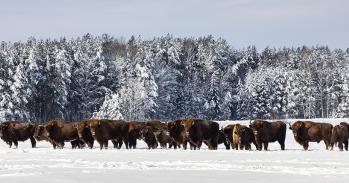
As societies face the triple challenge of avoiding the worst effects of climate change, protecting remaining biodiversity and improving human wellbeing, there are calls to end siloed thinking and design solutions that address these problems simultaneously.
As societies face the triple challenge of avoiding the worst effects of climate change, protecting remaining biodiversity and improving human wellbeing, there are calls to end siloed thinking and design solutions that address these problems simultaneously.
Nature-based Solutions (NbS) – solutions to societal challenges that involve working with nature – are such a solution. Examples include tree planting to sequester atmospheric carbon and restoring coastal habitats to mitigate floods.
Now, a group of researchers led by Professor David Coomes and Rogelio Luque-Lora from the University of Cambridge Conservation Research Institute, have published a policy briefing outlining the underlying concepts of NbS as well a list of strategies and policy recommendations to take NbS to their full potential, in advance of the United Nations Climate Change Conference which will be held in Glasgow later this year.
The briefing has been produced in association with the COP26 Universities Network, a group of UK-based universities and research institutes, including the University of Cambridge and Cambridge Zero.
As explained by the authors, Nature-based Solutions can deliver both climate change mitigation and adaptation. Mitigation involves reducing the degree of climate change: planting trees to absorb carbon dioxide, for example. Adaptation is about reducing communities’ exposure and vulnerability to the negative effects of climate change, by providing flood protection, for example. And by enhancing biodiversity, NbS can also boost the resilience of ecosystems to changing climate conditions.
Nature-based Solutions often work by protecting existing ecosystems, which prevents further release of carbon into the atmosphere and safeguards the biological diversity attached to those ecosystems. They can also work by restoring habitats which have previously been degraded, improving the ability of these habitats to sequester carbon and host biodiversity. Both these strategies also have the potential to enhance the provision of ecosystem services, including water filtration and soil retention.
Other strategies include the sustainable management of working landscapes, such as agricultural land, and the creation of new habitats. The latter has also been referred to as ‘green engineering’ or ‘green infrastructure’, and can contribute to societal adaptation to climate change by cooling and cleaning the air in cities and providing physical and mental health benefits.
In the UK, NbS can support job creation and livelihoods, and can play a key role in ‘building back better’ after COVID-19 and can be more cost-effectively deployed than non-NbS approaches to mitigation and adaptation.
There is also scope for the UK use its presidency of COP26 to promote effective and fair NbS across the globe. In this context, the authors recommends that the UK promotes a broad range of NbS that go beyond the present emphasis on tree planting. In fact, while the authors acknowledge that commercial forestry plantations can be necessary to meet societal demand for timber and wood pulp, they caution that the promotion of afforestation with non-native species can have detrimental effects on biodiversity, for example when they replace species-rich grassland ecosystems. They can also lead to the release of carbon into the atmosphere, if carbon-rich habitats such as peatland are replaced by the shallower soils of plantations.
The authors warn, too, that NbS can never be a substitute to the urgent and thorough decarbonisation of the economy. NbS can only contribute to meeting international climate targets if they act as a complement to the main task of transitioning away from fossil fuels. There is a risk that NbS could be used to justify ‘business as usual’, by conveying the illusion that emissions are being compensated for by deploying NbS.
NbS are most effective when they are strategically deployed to minimise trade-offs and deliver simultaneous wins. For example, restoring upland peat in the UK can help to protect communities from flooding and soil erosion while also storing carbon, providing recreational space and natural habitat for wildlife with negligible loss of agricultural potential on the national scale. In contrast, replacing highly productive agricultural land with natural habitats could make the UK more dependent on food imports.
Also, crucially, local communities must be involved in every stage of the planning and implementation processes. This is essential to ensure that local people do not overwhelmingly bear any costs associated with NbS, that they receive a just share of the benefits, and that they support the projects in the medium and long terms.
“I am excited by the opportunities that COP26 will provide to make the most of the potential of NbS to deliver climate change mitigation while benefitting biodiversity and livelihoods,” said Coomes.

The text in this work is licensed under a Creative Commons Attribution 4.0 International License. Images, including our videos, are Copyright ©University of Cambridge and licensors/contributors as identified. All rights reserved. We make our image and video content available in a number of ways – as here, on our main website under its Terms and conditions, and on a range of channels including social media that permit your use and sharing of our content under their respective Terms.




